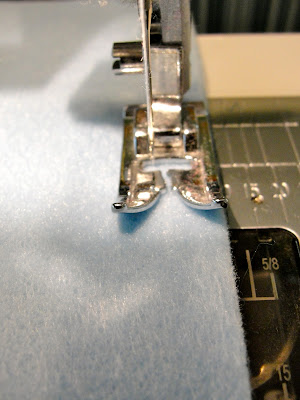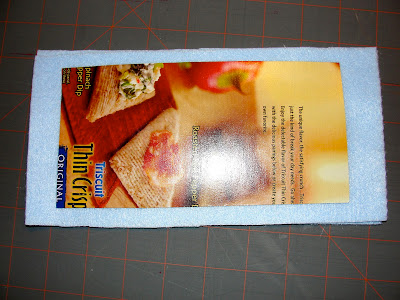Part 2 of 2: A Brief Apologetic with Additional Resources
Because Mormons send out over 50,000 missionaries each year, there is a good chance that one of them has knocked at your door in the past. Being in the west, there is a much stronger presence of Mormons then when we were in Kansas. As I said before, since our neighbors are Mormon, we have had 3 or 4 sets of Mormon missionaries in our house for a total of 10 or more visits in the past year. So, what goes on when Mormons come to your door and how should you respond as a Catholic?
 Step one: Invite them into your home.
Step one: Invite them into your home.
Your goal is to share with them the Catholic faith and why you are Catholic (assuming the person reading this is Catholic :) ) At times, we have felt like not having Mormon missionaries in our house, especially after having different missionaries into our home several times. But, I think it is important to talk to people about the faith whenever you have the opportunity, especially if they are willing to come to your front door! The missionaries that we have spoke to told us that they enter one home for about every 100 doors they knock on. They will be very excited if you invite them into your house.
 Step two: Let the missionaries explain themselves and tell you about Mormonism.
Step two: Let the missionaries explain themselves and tell you about Mormonism.
If they share with you about their faith, it is only natural for you to share why you believe what you believe as well. I always tell them that I am interested in the truth. If they have the truth, then I will accept it. This is a true statement even if I don’t believe they have the truth.
The goal of a Mormon missionary when they come to your door is to have you baptized in the Mormon Church. They beginning with the story of Joseph Smith and tell of the visions he received (for more on these read part 1). Essential to these visions is the idea that all Churches were false and that through the angel Moroni, God gave Joseph Smith the Book of Mormon to restore the Church from falsehood.
So, how did the Church run into error? The Mormons believe in what they call the Great Apostasy. After the death of the last Apostle, they believe that no one had the authority to correctly teach the faith. Because of this, the Church slowly fell away from the teachings of Jesus and became corrupted. They will claim that the Protestant Reformation made some strides in coming back to the truth, but that the revelations of Joseph Smith and the Book of Mormon were needed to establish the true Church once again.
Step three: Explain the Catholic Faith
Overall, you goal is to be charitable, defend the Church from their attacks, give your testimony, and show why you believe that Joseph Smith is not a true prophet.
1. Be Charitable
Hopefully, this is easy. Invite them in. Give them something to drink and have a snack on hand. Most Mormon missionaries have never experienced Catholics who can articulate their faith and do so with hospitality. They might not remember anything we say, but my hope is that they remember what it was like to be in our home and how we treated them with respect. I honestly think this impacts them more than any arguments.
2. Defend the Church from their misunderstandings.
When they bring up the Great Apostasy, it is a good time to step in and explain what the Catholic Church believes. This should be your main topic. Ironically, Mormons and Catholics both have a very strong belief about Apostolic authority. Catholics believe that this line of authority started with the Apostles and continues today. Mormons believed it was discontinued until Joseph Smith and continues in their Church today. Mormons will tell you either Mormons or Catholics are the true Church because of this. The Great Apostasy is really the determining factor.
The missionaries will begin to use Scripture mainly from the New Testament to try to show that Jesus and the Apostles foretold of the Great Apostasy. Here are some verses they might use: Mt. 24:4-12; Mk.. 13:21-23; Lk. 21:7-8; Acts 20:29-30; 2 Thess. 2:1-12; 2 Tim. 3:1-7; 2 Tim. 4:1-4; 2 Pet. 2:1-3; and Jude 17-19.
Many of these verses talk about believers falling away from the faith. However, none of them speak to the entire Church falling away. Plus, if you read them in context, some of them don’t even apply whatsoever. The sharpest missionary who came to our house was the son of a Mormon seminary professor. After I refuted several of these verses, he finally admitted that none of them directly foretold of the Great Apostasy.
Not only do their verses not prove the Great Apostasy, there are several Bible verses that are directly opposed to this idea.
I think the best two are the following:
Matthew 16:17-19
And Jesus answered him, "Blessed are you, Simon Bar-Jonah! For flesh and blood has not revealed this to you, but my Father who is in heaven. And I tell you, you are Peter, and on this rock I will build my church, and the powers of death shall not prevail against it. I will give you the keys of the kingdom of heaven, and whatever you bind on earth shall be bound in heaven, and whatever you loose on earth shall be loosed in heaven."
The gates of hell should not prevail over the Church. If the authority of the Church fell away after the last Apostle, then this statement is not true. The gates of hell did overcome the Church and reeked havoc for 1600 years.
John 14:16-18
I will ask the Father and He will send you another Advocate to be with you always, the Spirit of truth, which the world cannot accept, because it neither sees nor knows it. But you know it, because it remains with you, and will be in you. I will not leave you orphans.
How could we go into such darkness and falsehood with the Spirit of Truth?
Giving verses back-and-forth can only take you so far because Mormons do not look at Scripture the same way that Catholics and Protestants do. They are much more intent on trusting in the message of Joseph Smith and their conviction by the Holy Spirit about his message. I don’t think you should spend too much time on it, but I also think it is important to defend the Catholic Church.
3. Give Your Testimony
Testimony is very important for Mormons. They will almost always share their testimony with you--that they believe in Jesus Christ and that they know that the book of Mormon is true. I think it is important to share your testimony as well. It helps show that you are a person of faith that has been convicted of your beliefs.
So, how do you give a testimony? Well, it doesn’t have to be anything elaborate or detailed. If you are a person of faith, chances are you had a point in your life when you made a definitive decision to practice your faith. Just tell them what your life was like before you made this decision, why you came to this decision, and what your life has been like with your faith (for instance, the power of the Eucharist in your life). Again, this doesn’t have to be elaborate.
4. Was Joseph Smith a True Prophet?No matter what the discussion is, a Mormon missionary will almost always end the conversation by asking you to read the book of Mormon and to see if the Holy Spirit convicts you that it is the word of God. The conviction will come in the form of a feeling.
A few problems with this:
1. Historians have shown that the Book of Mormon contains many verses from the King James Bible. So, the Book of Mormon will sound a lot like the word of God.
2. I would challenge the claim itself. Feelings are subjective. In fact, while I have used reason to back up my Catholic beliefs, I also have several feelings associated with it as well. How do we know that something as subjective as feelings and emotions prove something?
3. At no other time has a true prophet asked anyone to do this. In fact, in Galatians 1:6-8, St. Paul gives us a very clear way of knowing what messages to accept:
“I am astonished that you are so quickly deserting him who called you in the grace of Christ and turning to a different gospel -- not that there is another gospel, but there are some who trouble you and want to pervert the gospel of Christ. But even if we, or an angel from heaven, should preach to you a gospel contrary to that which we preached to you, let him be accursed” (italics and bold mine).
So, is there anything in Mormonism that goes directly against the Gospel found in the New Testament? Yes, many things, but let’s focus on one: Polygamy and Eternal Marriages.
Polygamy is perhaps the Mormons most radical teaching. Key point here: The Mormons no longer practice Polygamy, but they do still believe in it. They only stopped practicing it because it was against the law. Also, attached to the teaching of polygamy is that to obtain the highest level of godhead one should practice polygamy and seal the marriage for time and eternity.
Mormons will point to the Old Testament to show that God allowed polygamy in the past (Abraham, David, Solomon, etc.) I do not believe that these practice equal God’s approval, but it isn’t worth arguing with them on this point. (For instance, after Abraham takes up Hagar as a second wife, the next time God speaks to him, Abraham is circumcised. The punishment seems to fit the crime. Enough said.)
The best place to turn is Matthew 22:23-30:
“The same day Sadducees came to him, who say that there is no resurrection; and they asked him a question, saying, ‘Teacher, Moses said, “If a man dies, having no children, his brother must marry the widow, and raise up children for his brother.” Now there were seven brothers among us; the first married, and died, and having no children left his wife to his brother. So too the second and third, down to the seventh. After them all, the woman died. In the resurrection, therefore, to which of the seven will she be wife? For they all had her.’ But Jesus answered them, ‘You are wrong, because you know neither the scriptures nor the power of God. For in the resurrection they neither marry nor are given in marriage, but are like angels in heaven.’”
First, both Jesus and Sadducees makes the assumption that marriage ends with death. This is why the woman in the story can marry someone else. Second, the question is who is she married to in heaven. Jesus’ answer, no one presumably because there is no marriage. This is made clear by the fact that they will be like angels, in so far as angel aren’t married.
The Mormons might respond that since Jews didn’t seal their marriages they wouldn’t be married in heaven. But, the overall point is that there is no marriage at all in heaven whether there is a sealing or not.
The question with this verses and several others comes down to this: Who do you believe in more Jesus or Joseph Smith? Whose word is greater Jesus’ or Joseph Smith’s? Ultimately, I believe the Mormons have to answer Joseph Smith (although they would never say this). Smith gave with a greater and more complete revelation. Smith built a restored Church that would not fall away. But, this doesn’t make any sense. Why is Smith more powerful and effective then God Himself?
Plus, Smith’s actions seem to demonstrate why he was not a prophet. Several things stand out, but his marriages are the most obvious. Not only did he have polygamous marriages, but he also married 10 women who were already married. This act of adultery comes directly against anything in the Old and New Testaments. (For a full list of wives go here.)
Again, while these are ad hominem attacks, the worth of a prophet is based on the character of his message and his personal character as well. Just remember to be forthright, but also charitable when explaining these points.
I tried to be brief as possible, but it is a hard thing to do. I feel like I have just touched on the surface of this topic. Feel free to shoot me a question on this if you have any.
Here are some great resources for more information:
Here is a great book online about Mormonism and here is a very helpful article by Patrick Madrid, a Catholic apologist, on Mormonism.



















































